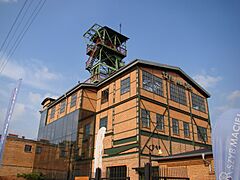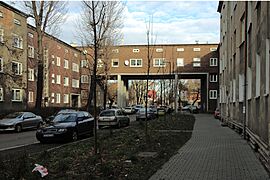Zabrze facts for kids
Quick facts for kids
Zabrze
Zŏbrze (Silesian)
|
|||
|---|---|---|---|

Ulica Wolności (Liberty Street)
|
|||
|
|||
| Country | |||
| Voivodeship | Silesian | ||
| County | city county | ||
| Established | thirteenth century | ||
| City rights | 1922 | ||
| Area | |||
| • City | 80.40 km2 (31.04 sq mi) | ||
| Population
(31 December 2021)
|
|||
| • City | 168,946 |
||
| • Density | 2,140/km2 (5,500/sq mi) | ||
| • Urban | 2,746,000 | ||
| • Metro | 4,620,624 | ||
| Time zone | UTC+1 (CET) | ||
| • Summer (DST) | UTC+2 (CEST) | ||
| Postal code |
41–800 to 41–820
|
||
| Area code(s) | +48 32 | ||
| Car plates | SZ | ||
| Primary airport | Katowice Airport | ||
| Highways | |||
| Website | https://www.um.zabrze.pl | ||
Zabrze is an industrial city in southern Poland. It is located in a region called Silesia, close to Katowice. The city is part of a large urban area with about 2 million people. Zabrze is found in the Silesian Voivodeship, a type of province in Poland.
The city's population was about 168,946 in December 2021. Zabrze is surrounded by other cities like Gliwice, Bytom, and Ruda Śląska.
Contents
History of Zabrze
How Zabrze Began
The area of Zabrze has a long history. One part of the city, Biskupice, was first mentioned in 1243. The name Zabrze itself appeared around 1295. People started mining in Zabrze as early as the 13th century.
Archaeologists have found ancient tools from thousands of years ago in the Mikulczyce area. In the past, German settlers were invited to live here. Zabrze became part of the Habsburg monarchy in 1526. Later, it was taken over by the Kingdom of Prussia.
In 1791, a special type of coal called coking coal was found in Zabrze. This led to the opening of the first coal mine. During the 1800s, more coal mines, steel factories, and power plants were built. Roads and railways also connected Zabrze to other cities.
Early 1900s Changes
In 1905, different parts of Zabrze joined together to form one community. In 1915, its name was changed to Hindenburg to honor a German general. Before this, it was one of the few cities that kept its Polish name under German rule.
A Polish sports group called "Sokół" was active in Zabrze. It also worked to support Polish independence. Its members helped during important events after World War I.
Between the World Wars
After World War I, people in the Hindenburg area voted on whether to stay with Germany or join Poland. Most voted to stay with Germany. However, some areas that are now part of Zabrze, like Kończyce, joined Poland.
Hindenburg officially became a city in 1922. It quickly grew to be a very big city in its region. Even though it was in Germany, many Polish groups, libraries, and sports clubs still operated there. Polish newspapers were also published in the city.
In the 1920s, different political groups were popular. Some even suggested changing the city's name to Leninburg. By 1933, a political party called the Nazi Party gained the most votes.
Polish people and the Jewish community faced increasing difficulties during this time. Polish names were encouraged to be changed, and Polish writings were removed from old monuments. The city's synagogue, a Jewish place of worship, was destroyed in 1938 during a terrible event. Many Jewish people were forced to leave or were sent to terrible camps.
Zabrze During World War Two
During World War II, the German government took over church properties. Church bells were taken to be used for the war. The Germans also set up places where prisoners of war and others were forced to work. Some of these were in local coal mines.
In January 1945, the city was taken by Soviet forces. After the war, many inhabitants moved away or were relocated. However, many people who spoke both Polish and German were allowed to stay.
Modern Zabrze
After World War II, in 1945, Zabrze became part of Poland again. Its historic name, Zabrze, was restored. The first mayor was Paweł Dubiel, a Polish activist who had been held in terrible camps during the war.
Poles who had lived in the region before the war stayed. Other Poles, who had been forced to leave their homes in eastern Poland, also moved to Zabrze. The city grew, and new neighborhoods were built.
In 1948, the Górnik Zabrze football club was started. It became one of Poland's most successful football teams, winning many championships.
City Layout
In 2012, the city council divided Zabrze into 15 districts and 3 housing estates. These are like smaller neighborhoods within the city.
- 1. Helenka
- 2. Grzybowice
- 3. Rokitnica
- 4. Mikulczyce
- 5. Młody Górnik estate
- 6. Mikołaj Kopernik estate
- 7. Biskupice
- 8. Maciejów
- 9. Tadeusz Kotarbiński estate
- 10. Centrum Północ
- 11. Centrum Południe
- 12. Guido
- 13. Zaborze Północ
- 14. Zaborze Południe
- 15. Pawłów
- 16. Kończyce
- 17. Makoszowy
- 18. Zandka
Getting Around Zabrze
Major highways run through Zabrze, connecting it to other parts of Poland and Europe. These include the A1 and A4 motorways. Other important national roads also pass through the city.
Culture and Things to See
Zabrze has many cultural places. You can visit the Zabrze Philharmonic for music or the Teatr Nowy (New Theatre) for plays. The Dom Muzyki i Tańca (House of Music and Dance) is a large indoor venue.
There are also several museums:
- The Coal Mining Museum
- The Municipal Museum
- The Military Technology Museum
You can visit historic coal mines like the Maciej mine shaft and the Main Key Adit. These old mines are recognized as important historical sites in Poland.
The city also has interesting old buildings. Some were built in unique styles like Expressionist and Modernist architecture. Examples include the Admiralspalast Hotel and St Joseph's Church. There are also monuments that remember the city's history, especially the Silesian uprisings and World War II.
Zabrze also has a botanical garden and several parks where you can relax.
Sports in Zabrze
Zabrze is famous for its sports teams. The most well-known is Górnik Zabrze, a very successful football club. They have won the Polish championship 14 times. They are also the only Polish team to reach the final of a major European football competition.
Another popular team is NMC Górnik Zabrze, which plays men's handball. They have won the Polish championship twice. Both teams play in the top leagues in Poland.
Many famous athletes were born in Zabrze. These include footballers Jerzy Gorgoń and Łukasz Skorupski, and ice hockey player Wojtek Wolski.
Zabrze's Economy
Zabrze is an important center for making things. It has coal mines, iron and wire factories, glass factories, and chemical plants. There is also a local brewery.
Famous People from Zabrze
Many notable people have come from Zabrze, including:
- Jerzy Gorgoń (born 1949), a Polish former football player.
- Janosch (born 1931), a German author.
- Krystian Zimerman (born 1956), a Polish classical pianist.
- Sebastian Kawa (born 1972), a Polish glider pilot and world champion.
- Wojtek Wolski (born 1986), a Polish-Canadian ice-hockey player.
- Bartosz Bednorz (born 1994), a Polish volleyball player.
International Connections
Consulates
Zabrze has an Honorary Consulate of Armenia. There is also a special stone monument called a khachkar in Zabrze. It celebrates the friendship between Armenia and Poland.
Sister Cities
Zabrze has "sister city" relationships with several cities around the world. This means they share cultural and educational ties.
- Essen, Germany
- Lund, Sweden
- Rivne, Ukraine
- Rotherham, England, United Kingdom
- Sangerhausen, Germany
- Seclin, France
- Trnava, Slovakia
- Zahlé, Lebanon
See also
 In Spanish: Zabrze para niños
In Spanish: Zabrze para niños
























